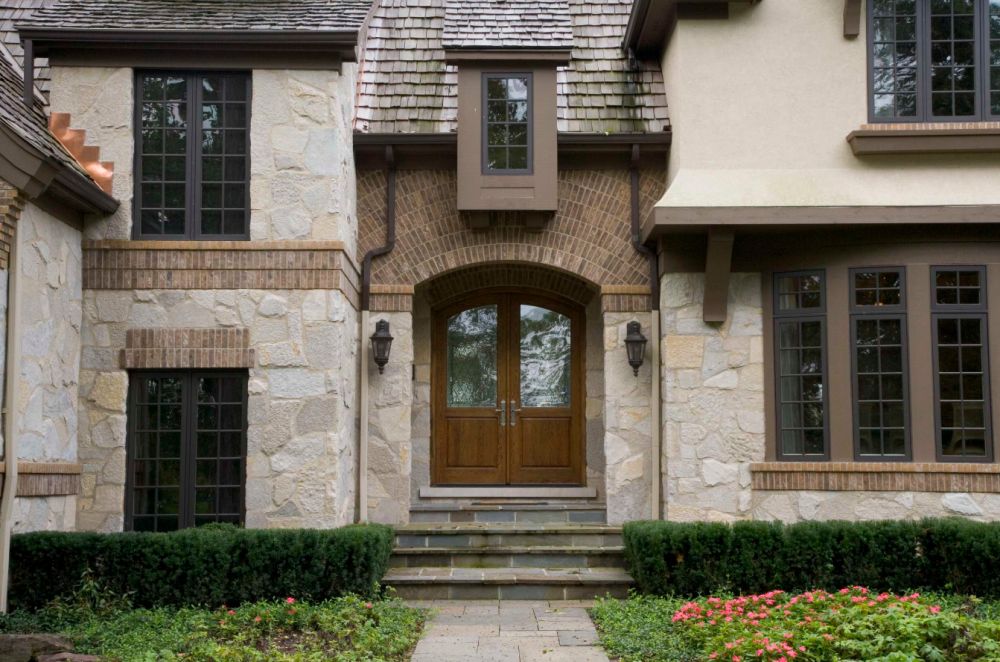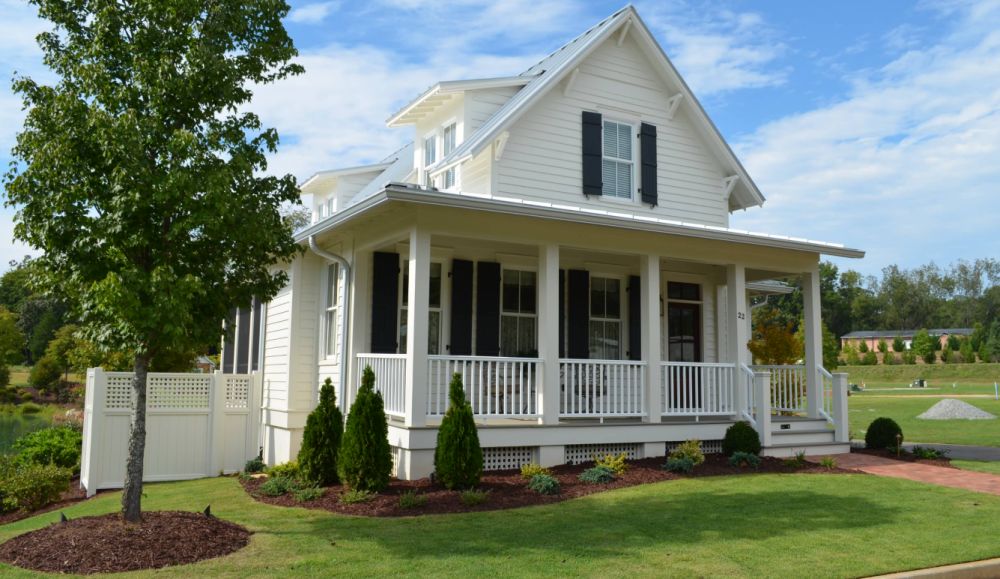New house siding is the best way to improve a home’s exterior. Aside from the siding’s look, you also need to consider price, longevity, energy efficiency, and maintenance.
There are many types of house siding. Each comes with its own set of pros and cons, and not every type will fit every architectural style. It’s important to pick one that best suits your home.
In a rush? Get A Quick Answer To Your Siding Needs:
The History Of Exterior House Siding
US homes began using aluminum and steel siding in the 1940s. Earlier types of house siding, like brick, date as far back as 7,000 BC. When siding became common among American homes, aluminum was the most popular choice, followed by steel. Both styles carried into the 60s when vinyl emerged as the top siding choice due to its affordability. Since then, other types of house siding have debuted, offering greater protection, more style choices, and long-lasting durability.
The Best House Siding Colors Of 2023
When choosing new siding, color is an important factor to consider. To help you find the best color for your home, check out the following list of the best house exterior colors for 2023.
- Aegean Olive
- Black Forest Green
- Sussex Green
- Deep River
- Ocean Floor
- Stonecutter
- Midsummer Night
- Black Beauty
Types Of House Siding
Split-Log Siding

Split log siding is versatile and works well with many home styles. The wood exterior cladding looks like split logs which serve as a defining characteristic of the cabin aesthetic. Made with oak, cypress, or cedar, wood siding is popular among mountain getaways and ski village retreats.
Split log siding is the ideal choice for country and traditional ranch homes like this one designed by Ertel Associates Architects.
How To Install Log Cabin Siding in 6 Easy Steps
Before you install log cabin exterior house siding, add primer or pre-finish to your siding surfaces after you’ve preconditioned everything. When you do this, it reduces shrinkage and unfinished lines from appearing. It will also protect your siding from cupping and splitting.
Tools needed to install log cabin siding:
- Measuring tape
- 6’ level
- Chalk
- Caulk
- Power drill
- Nails
and the steps:
- Measure – The first row is the most important, so make sure it’s straight and level. Use chalk lines to mark it. Measuring the height and width of the first row will provide you with an outline.
- First Row – Place the first log at the base without installing it. Level one piece at a time without attaching it. Attach each log with screws or galvanized nails, drilling through the tongue into the stud.
- Stagger Corner Joints – With saddle notch corners, stagger your joints. Depending on the size of your home, one-foot staggers are the norm.
- Tongue And Groove – After the first corner is set, use the log siding with the tongue and groove to finish the side into the inside corner. Install log siding with the tongue facing up to prevent water from being trapped between the boards.
- Nail Siding – You don’t want your nail holes to be visible, so nail the log siding at an angle through the tongue and into the backboard or studs. Do not nail through the siding’s face.
- Caulk Exterior Corners – After installing the siding, apply caulk between the corners. This will prevent moisture from damaging the finish.
Board And Batten Siding

Most board and batten siding is made of wood, but vinyl options are available. You can install the boards vertically or horizontally, depending on the look you like best. Either way, the panels will influence the look of your home, making it appear taller or wider. Board and batten siding is popular among contemporary farmhouse-style homes. It’s also good for traditional and modern homes like the one in the photo.
Board and batten siding consists of wide board strips that are 1-foot wide, and battens are 1/2 inch wide. It offers a similar look to interior wainscotting or beadboard. When searching for modern siding ideas, this option will pop up on your radar.
Depending on the size of the home and the thickness of the material, vinyl board and batten siding will cost between $2 and $7 per square foot. Another factor that will impact the price is if the materials are insulated or non-insulated.
Pros:
- Durable – can withstand harsh weather climates.
- Versatile – works on any type of home.
- Long-lasting – lasts longer than other types of house siding, depending on the material
Cons:
- Time -installation takes longer than other house siding styles because there are more pieces to install.
- Expensive – because the installation process includes more pieces, it takes longer and therefore costs more.
Wood Shingle Siding

Natural wood shingles give houses a natural and rustic look, helping them blend into their surroundings. They’re more expensive than vinyl and aren’t low maintenance – wood shingles require ongoing care and attention. You should know in advance that the installation process is time-consuming. Heartwood Corp. in South Hampton built this home that’s clad with wood shingle siding.
Wood shingle siding is available in different wood species, such as cedar wood shingles, eastern white cedar shingles, and red cedar shingles.
Pros:
- Durability – wood shingles will last for decades when well-maintained.
- Variety – wood shingles come in a variety of styles and colors that can fit with any home.
- Insulation – your home will be better protected from cold weather with wood shingles.
Cons:
- Expensive – on average, you can expect to pay more than other types of siding.
- Environment – in wet and rainy environments, the shingles will degrade faster.
- Insects – if you don’t protect your shingles with stain or finish, you will have problems with termites and wood borers.
How To Stain Wood Shingles
The easiest way to stain wood shingles is before installation, but you can also do it after they’re on your house. Before you begin, your shingles must be clean and dry. For best results, rent a power washer to clean hard-to-reach spots. You also want to install shingles when rain isn’t expected for at least three days.
- Fill a bucket with stirred stain to 75 percent capacity.
- Cover the trim with strips of 2-inch painter’s tape. Press the painter’s tape against the window trim.
- Cover all greenery, sidewalks, and other objects within four feet of the shingles with drop cloths or plastic sheeting.
- Using a stir stick, add the 5-gallon oil-based wood stain with the stirred stain.
- Paint the shingles with the stain in a vertical motion. You want the bristles to get in between the shanks and groves.
- Stir the stain container before adding more to the paint bucket.
Horizontal Wood Siding

Otherwise known as lap siding, horizontal wood siding gives houses a classic look but comes at a cost. The advantage is that this type of house siding is not linked to any style and can go with stain or paint. For example, this house designed by Place Architecture has a modern appearance.
Pros:
- Versatile – lap siding is available in vinyl, wood, and fiber cement.
- Low maintenance – depending on where you live and the material, the siding only needs to be cleaned once or twice a year.
- Durability – can last upwards of 40 years.
Cons:
- Discoloration – this will depend on how much sunlight your home receives.
- Insects – dust can easily accumulate, which will turn into insect breeding grounds.
- Paint – direct sunlight will hurt the siding, so you’ll have to paint it to keep it looking fresh.
Metal Siding

Metal siding is ideal if you want your home to have a modern-industrial appearance like this one from WA Design. Steel siding (we can talk about corrugated metal siding also) offers durability and extra protection from pests and fire, plus it doesn’t warp.
There are a few drawbacks – mainly that this siding has problems retaining heat in colder climates. However, steel siding weathers nicely and will gain a unique patina.
Pros:
- Strength – metal siding is stronger than most types of house siding.
- Fire Resistant – offers greater protection from fire risk.
- Curb Appeal – the siding will give your home an industrial look.
Cons:
- Rust – metal is susceptible to rust.
- Cost – it’s more expensive than most types of siding.
- Denting – in climates that have hail storms, metal siding can be easily damaged and pierced.
Stone Siding

Natural stone siding is timeless and great for a structure when you want a rustic or traditional style. It’s weather-resistant and low maintenance. Natural stone siding has a charm that other types of house siding lack. However, that charm comes with a high price tag. It’s also not DIY friendly – you’ll need professional siding installation.
This craftsman-style house designed by Studio 6 Architects is a fine example as it showcases the beauty of rustic-looking house siding.
Pros:
- Authenticity – stone siding will give your home an authentic look.
- Sustainability – because it’s natural, it isn’t bad for the environment.
- Recyclable – stone siding can be torn down and used again.
Cons:
- Cracks – stone siding cracks easily if it’s not installed properly.
- Mold – water can seep into the cracks, which will cause mold and mildew problems.
- Expensive – due to local regulations, you will need to hire a stone masonry expert to install the siding.
Faux Stone House Siding

If you like natural stone siding but the price is out of your budget, there’s an alternative: faux stone. It’s not as durable or long-lasting as natural stone, but it costs less, and it looks convincing. With a bit of maintenance, you can enjoy it for a long time. If you’re not convinced, check out this great house built by Orren Pickell Building Group.
Pros:
- Long-lasting – warranties range from 20 to 75 years.
- Fire-resistant – more fire-resistant than wood or vinyl siding.
- Versatility – because the material is lighter, you can use it for other things that don’t support the weight of the natural stone.
Cons:
- Moisture – if not installed properly, water can leak in and cause mold.
- Caulk – if you do not use caulk, you can expect leakage problems.
- Maintenance – perform regular inspections to ensure there are no cracks or lifting pieces.
Brick Siding

There aren’t many brick houses that feature a traditional brick masonry method. One reason is due to labor-intensive brick siding installation, which is expensive. Brick siding has a classic look and is one of the earliest types of house-building materials, originating in Turkey.
Brick siding exterior walls are low maintenance and last longer than other types of house siding, which makes it a sound investment. It costs between $6 to $15 per square foot. It suits traditional homes like the one built by general contractor Andrew Roby.
Pros:
- Eco-friendly – because brick is made with natural materials, it’s easier on the environment.
- Low Maintenance – you won’t have to worry about painting or cleaning.
- Durability – bricks can withstand harsh weather conditions.
Cons:
- Expensive – brick siding is more expensive than most types of house siding.
- Sealing – in heavy water environments, apply sealant every eight years or so.
- Humidity – environments with high humidity will cause moisture and mold issues.
Glass Siding

Glass is an ideal option if you wish to enjoy panoramic views from a house filled with natural light. Other advantages of a glass exterior wall include energy efficiency. The downsides are the high cost, lack of privacy, and need for regular cleaning. With all of this in mind, we think glass houses are amazing. This elevated concrete house is one of our favorites.
Pros:
- Lightweight – glass naturally weighs less, so you don’t have to adhere to load-bearing component specifications.
- Versatile – it offers more room for designers to be creative.
- Rust Resistant – unlike other contemporary building materials, glass doesn’t rust.
Cons:
- Fragile – glass, unlike wood, can shatter.
- Weak – it isn’t good in environments that have bad weather or earthquakes.
- Temperature – glass absorbs heat and can turn your living environment into a hot box.
Fiber Cement Siding

Fiber cement siding costs more than its vinyl counterpart but is still affordable. Reinforced fiber cement is made with protective material like Portland cement that adds to its long-lasting durability. Key benefits include termite, fire, and weather resistance – it can withstand 160 mph winds.
One of the big cons to fiber cement siding is moisture problems. Also, older versions of the siding from the late 80s and earlier may contain asbestos. If this is the case with your home, enlist a professional abatement contractor to remove the siding.
On average, installed fiber cement siding is between $6 to $12 per square foot. The siding is considered a great investment as it will last up to 50 years.
Pros:
- Fire protection – cement siding offers greater protection from fire.
- Durability – more durable than other types of house siding.
- Insect protection – offers greater protection against termite invasions.
Cons:
- Appearance – does not look like natural wood.
- Cracking – depending on the environment, cracking can be an issue.
Stucco House Siding

Stucco house siding is long-lasting, fire-resistant, and provides excellent insulation. You can apply it on wood, stone, and brick surfaces. However, stucco siding doesn’t do well in humid areas and is also expensive. Check out this house by Think Design Office to see what stucco siding looks like.
Pros:
- Durability – will last a long time if installed properly.
- Curb Appeal – works with many architectural styles to boost curb appeal.
Cons:
- Maintenance – if not installed properly, cracking can be an issue.
- Absorbent – stucco is porous, which means it absorbs moisture and can lead to mold and mildew issues.
Vinyl Siding

Versatility and customization are important when choosing types of vinyl house siding, which can outweigh longevity concerns. Combine that with a low cost, and you have the best house siding material for most contemporary homes: vinyl. It’s a synthetic material available in many colors and different forms like panels or shingles.
Vinyl can imitate the look of other materials like stone and requires little maintenance. An example of vinyl exterior siding can be seen in this house remodeled by John Bynum Custom Homes.
Vinyl Siding Pros And Cons
Insulated vinyl siding is great, but it isn’t perfect. Like anything else, it has built-in challenges to consider.
Pros:
- Energy efficient – high-quality vinyl cladding is efficient and may decrease energy bills.
- Protection – vinyl offers stronger protection from cold weather and absorbs outside noise.
- Impact resistance – vinyl siding doesn’t damage easily.
Cons:
- Unsustainable – sustainability is a major concern among US homeowners. When a home undergoes an upgrade or renovation, the project’s impact on the environment will be considered. Also, vinyl isn’t a green material, which means it’s unsustainable. Most recycling centers do not accept vinyl. When it is dumped in a landfill, it will harm the environment as it isn’t biodegradable.
- Warping and Cracking – depending on where you live, vinyl can warp and crack. In hotter climates, vinyl will show signs of warping within a few years of installation. Cracking is more common in freezing climates.
- Trapping – is caused by moisture build-up. If foam backing isn’t included with insulated vinyl siding installation, it will be susceptible to trapping.
Alternatives To Vinyl Siding
There are a few alternative house siding options available should your home require something unique or more affordable. If you like the features that come with vinyl siding but it’s not within your budget, consider the following options.
Engineered Wood Siding

Engineered wood is a wood composite siding. The protective fibers are made with heated wax and resin, which is pressed into the wood’s texture. In the world of contemporary exterior siding, this option is the latest breakthrough for residential homes.
Pros:
- Lightweight material – lighter than fiber cement and some wood siding materials.
- Eco-Friendly – uses recycled materials.
- Budget -Less expensive than other house siding types.
Cons:
- Requires maintenance – Not natural-looking and must be painted.
- Binding Agent Issues – Some binding agents are not eco-friendly and may contain carcinogens.
Aluminum Siding

Aluminum siding is a cheaper and less-durable option than vinyl. It’s rot and pest-proof and, depending on the gauge can be energy efficient. While aluminum siding used to be the standard in the US, it’s now more popular for contemporary or industrial-style homes.
Pros:
- Paintable – unlike vinyl, it can be painted.
- Low maintenance – besides cleaning, there’s no special upkeep.
- Changes color – aluminum develops a rustic patina over time.
Cons:
- Limited selections – not many manufacturers make aluminum siding.
- Less resilience – aluminum can rust, dent, and puncture.
- Varied energy efficiency – aluminum isn’t energy efficient in hot climates.
Frequently Asked Questions (FAQ)FAQ
How Long Do Eastern White Cedar Shingles Last?
On average, eastern white cedar shingles are replaced every 20 years.
What Is Board And Batten Siding Made Of?
Board and batten is commonly made of wood, but vinyl, fiber cement, and steel options are available. If durability is your biggest priority, so with engineered wood siding.
Can You Put Vinyl Siding Over Wood Shingles?
No, it’s a bad idea to put vinyl siding over wood shingles. Let’s think about this for a moment. You have no idea how much rot and mold accumulates underneath your wood shingles. Adding a layer of vinyl siding over damaged wood shingles would destroy your home. Adding wood shingles over your vinyl siding would not be a viable replacement option.
What Is The Difference Between Brick And Brick Veneer?
The difference between brick veneer and solid brick is support. With brick veneer, support is provided by a backup wall made of concrete, steel, or wood. With brick veneer buildings, the exterior brick is for cosmetic purposes and not a structure that’s supported entirely by bricks.
What Is Lap Siding?
Lap siding is a popular house siding. The term describes horizontal siding installations. “Lap” refers to how the planks overlap each other.
What Is The Best House Siding For A Tiny Home?
Because tiny houses are small, high-end siding is an affordable option because it requires fewer materials. For example, pine wood siding would cost a small fortune to install on a regular single-family dwelling. With a tiny home, pine wood siding, which sells for $3 per square foot, would be your best option for the money and quality.
What is Composite Wood Siding?
Composite wood siding is compressed scrap wood that’s bonded with resins. It’s treated with chemicals so fungi and insects can’t harm it. The siding is pre-primed, which means it’s ready to paint upon arrival. In the home construction industry, it’s otherwise knowns as fiberboard siding.
What Is The Best Fire Resistant Siding?
Composite siding and engineered wood siding are the most fire-resistant sidings on the market today. Engineered wood has fire-repellant chemicals that protect it from wildfire risks.
What Is The Cheapest Siding For A House?
Insulated vinyl siding is the cheapest house siding available on the market today. The average square footage for a home in the US is 2,500. Depending on where you purchase your vinyl siding, you can expect to pay between $1 and $2 per square foot. After you factor in other materials and labor costs, to install siding on an average-sized home, you could expect to pay almost $13,000.




